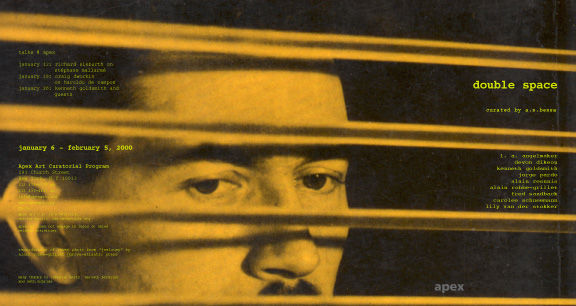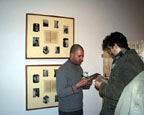  
|
double
space
curated by A.S. Bessa
In writing, the expression "double
space" is
used to define the maximum standard distance between two
lines in a text. Poetically, though, the term is rich in
ambiguities due to the intrinsic power of the words "double"
and "space." The exhibition explores the ideas related to space in text, the
architectural properties of writing, and the concept of text
as a construction.
January 5 - February 5, 2000
291 Church St. New York, NY 10013
Artists: l.a. angelmaker, devon dikeou, kenneth
goldsmith, jorge pardo, alain resnais, alain robbe-grillet,
fred sandback, carolee schneemann and lily van der
stokker |

download pdf of exhibition
brochure
download pdf of press
release

|
| ...departing
from hemingway's claim that writing is architecture
not interior decoration, and on the way trying to prove
him
wrong as to the second part of that statement.) think
of the case of robbe-grillet's jealousy whose architecture
seems disarmingly plain&simple forms for multiple purposes
(paragraphs made of sentences that repeat on and on,
blocks of text arranged in different combinations). the same
can
be said of the architecture in jealousy: square spaces
for multiple purposes (a colonial construction formed
by rooms of regular shapes, rectangles combined in different
patterns). in its original (jalousie) the title is
already
doubled as it refers both to jealousy and to venetian
blinds. the narrator inhabits these spaces like a ghost, for
he
is equivalent to the hypotenuse of a triangle whose
existence we only suspect and which is never confirmed. (the
two
other characters in this theorem, a… and franck, are
quite well defined, whereas the narrator's existence
is only
suggested but never really spelled out). the novel
is composed of right angles, and the narrator, a diagonal
to these
angles, is still to be deduced from the given measurements.
this narrator, such a fascinating concept, is in a
way a stand—in for both the writer and the reader,
facing a situation that unfolds independently of his
will. like
an edgar allan poe character, he seems to have been
walled up alive, caught between the interstices of
this space.
what he sees and can't prevent from happening is often
happening in another room, which he can only glimpse
through the blinds of a window. like this narrator,
the reader
is also walled in between the pages of the book-what
one reads and can't prevent from happening is happening
in
another space, which one can only glimpse between the
lines. the window's blinds parallel the lines of text
on the book's
page: one reads (through the blinds/lines) the narrator's
account of his reading through the blinds. it is thus
that robbe-grillet acknowledges the circular nature
of reading
(this circularity one only presumes, for it is only
experienced as a segment of an arc: the narrator is
reading a situation,
the reader is reading the narrator reading a situation,
etc). and how strange this book's wordplay: sun-blinds
and blindness, jalousies and jealousy. and what's more,
everything around seems to exist solely to end up in
this book: the sun goes up and down in its repetitive
motions,
casting geometrical shadows around the house, and even
the banana plantation expands further the organizing
principle of the text. if only chaos were this well
organized. there
will be, however, an element to mess up this geometry:
the centipede smashed on the wall by franck, in a scene
exhaustively analyzed from several perspectives, is
a stain at the center of robbe-grillet's rigid design
(its interior
decoration) and compromises the cleanliness of the
overall plan. the stain is the macula in one's realm
of vision,
a smear on the windowpane, the area that becomes most
visible; it indicates that between one's perception
and the object
being observed there is a screen. the stain points
to the artificial nature of the spectacle, bringing
one's attention
back to the surface of the page; the brechtian verfremdungseffekt.
the stain upsets (interrupts the course of reading)
and at the same time provides an opportunity to release
stress
(by making one aware of the materiality of the page).
the page is our most abstract invention, a window onto
a virtual
space (the lines of text working as a sun-blind that
filters the light [the brightness of the blank page,
the supremacy
of the white, is perhaps too harsh for one to endure,
and without these lines one would plunge into the void]).
in "pay
attention motherfucker!" bruce nauman addresses the
problem of the page-as-screen with such bluntness as
to lead one
to wonder what is so infuriating about it. in nauman's
artwork the text reads backwards, conveying again the
idea that the reader is caught in an in-between space,
walled
up, arrested by language. works such as nauman's and
robbe-grillet's are unsettling because they make evident
this effect in
art that we take for natural and translate as an emotion.
in these works simplicity is deceiving and fiction
is built up upon this deceit. after all, what the eye
apprehends
on the page is but a series of signs repeated in different
combinations. hence a new theory is made necessary—one
that would account for the mediation between these
doubled spaces, a sort of string theory of writing.
it would
go something like this: on this page, picture a grid
over
which these words (letters, basically) aggregate, each
letter a string curlicue-ing according to its own nature.
thus this theory of space/time would comprehend not
only three dimensions, or seven as is now proposed,
but twenty-six:
each string, a letter, driving the eye's attention
in a different direction, and the endless combinations
of
these
strings producing an infinity of things (words). the
mind scans the fabric of the text as if following a
thread, a line, a sentence. from left to right, from
top to bottom,
bridging gaps between the letters, between the words,
be...
A.S.Bessa
©1999 |
|
|

